A Guide to Watercolors and Bicycling (#BikePainting)
Taking a small and compact watercolor kit on a bike ride or bike tour has become one of my favorite analog pleasures. It forces me to slow down after a long day of touring or to be more present and use my skills of observation more during a quick sketch break.
As I do with all things from bikes to coffee to whiskey, I did a deep dive on equipment and techniques to find what worked best for ME. Watercolors can be as simple and as complex as you make it. Here is my quick-ish guide to watercolors and different kits for various budgets and interest levels.
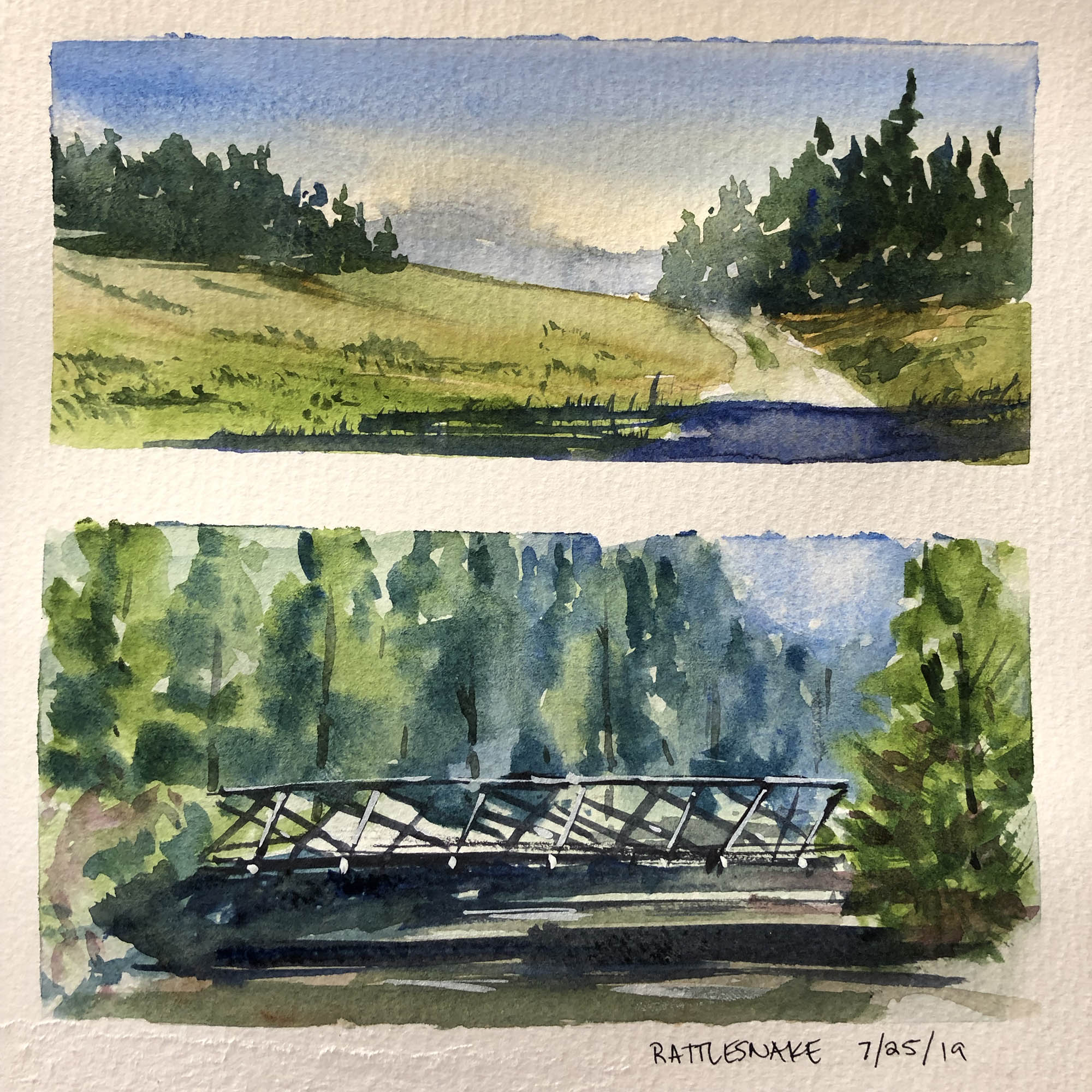
Student vs. Artist Grade Paint
The differences in paint between the student and artist grade paints is the amount of pigment and lightfastness. Student grade paints while less inexpensive in the short term actually become more expensive the more serious you get since it requires more paint to achieve the same level of pigmentation. Artist grade paints while expensive up front, require less waking up in the dry pans to get the similar level of color on the paper. If you have any inkling that your interest in watercolors will stick, I would suggest going straight to artist grade from the beginning, specifically this split primary set from Daniel Smith – it has all the colors you need when starting out.
Paper
If your colors aren’t as vibrant as you’ve hoped and you’re using artist grade paint and proper technique, a possible culprit is the paper. I’ve used varying notebooks and paper and it is shocking the difference between low quality and high quality paper is. Higher quality paper have high cotton content (100% being the best of course). A good example of high quality paper is Arches. It can be expensive and intimidating at first, but a good idea is to buy a pad or a sheet from your local art store and compare it to cheaper papers to see what you are missing out on.
Another decision to make about paper after weight and cotton content is Cold Press vs. Hot Press. Cold press is more textured (think goosebumps on your skin when you’re cold) and allows for dry brush techniques and generally feels more painterly. Hot press has a much smoother texture and doesn’t highlight brush work as readily. If you want a more painterly feel, I would suggest Cold Press. If you lean towards more ink work / urban sketcher aesthetic Hot Press is a better choice since the smoother surface won’t eat up your pen tips.
ProTip: PAINT SMALL! When you’re first starting out it is super intimidating to “waste” paper and art supplies. I have found the best way to get over the fear is to use masking tape and turn larger sheets into smaller panels. You learn more by doing a dozen small studies than agonizing over one large finished painting. Take the stress off and paint small!
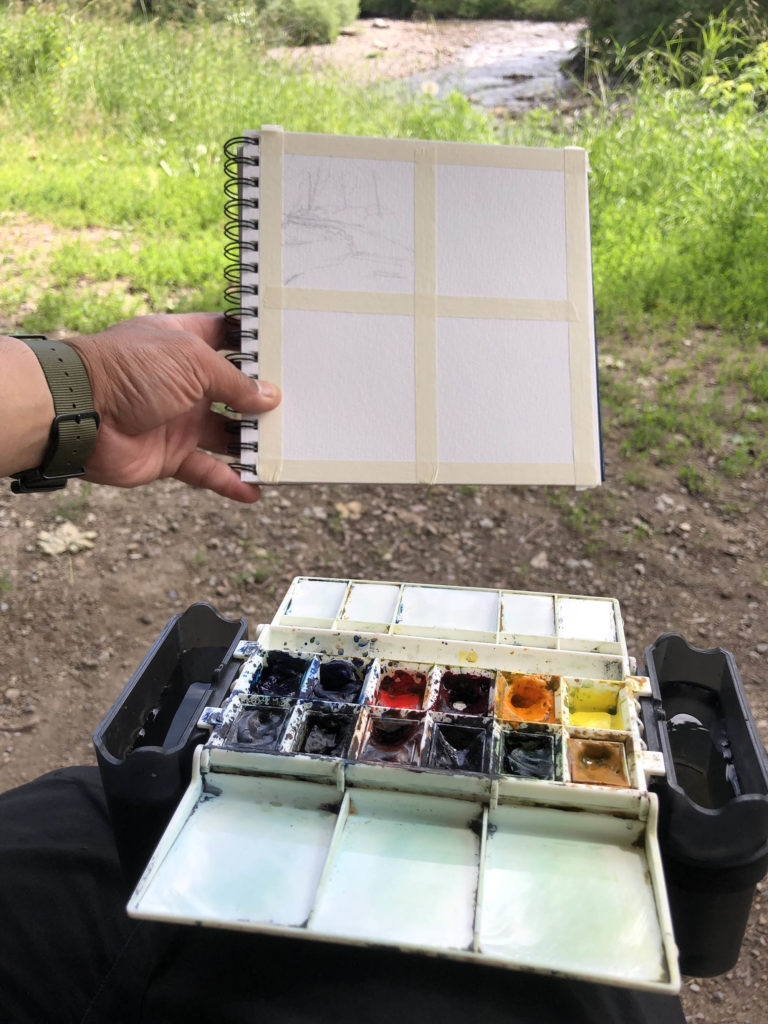
Watercolor Notebooks:
If you do plan to paint and pedal, notebooks are the most convenient form. Here are my favorites:
Moleskin Watercolor – closer to a hot press in feel though with some texture, not the highest cotton content so it can’t absorb heavy levels of water, best use for pen and watercolor techniques. Easy to find most places.
Pentalic AquaJournal – more texture than the Moleskin, can absorb heavier washes but still pen friendly. Comes in a variety of sizes and shapes (square for those ‘gram pics) and easily available.
Handbook Watercolor Journal– a half step up from the Pentallic AquaJournals. Slightly better paper with more natural looking texture. Comes in various sizes and is spiral bound so paper can be laid flat.
Strathmore 500 Watercolor Travel Journal – high quality watercolor paper in a staple bound and pad form. Great texture for dry brush techniques. Comes in smaller convenient sizes that will fit in a handlebar bag. Not inexpensive but worth it for the best portable pure watercolor experience.
Brushes
A good brush will last a long time and will be a joy to use. For expediency, water brushes are great but they can be difficult to control. Often times I find myself using too much water and colors aren’t as vibrant. In a pinch, they work but aren’t my personal favorite.
For my style where I generally lay down an initial broad wash of color and go back with more detail after it dries, I really on two types of brushes: Mop/quill brush and a round brush.
The mop or quill brush is characterized by having large water and pigment capacity (often the hairs are bound with wire) and is used for laying down the initial washes or layers of color: blocking in the warm and cool areas of the painting. Some quill brushes are also able to maintain a fine enough point for the later stages of a painting as well and some artists can paint an entire painting only using a quill brush. I’ve tried several from pure squirrel hair brushes to synthetics and my preference is for synthetics. While natural fiber quills are luxurious to use they can hold TOO MUCH water and easily saturate a travel notebook and are harder to use for finder details. For synthetics I like the Raphael Soft Aqua ( you can see them put to good effect on Tim Wilmot’s channel) and the new Da Vinici Casaneo line. Currently, I lean towards the Da Vinci’s more because they seem to hold a finer tip and the size 4 or 2 is perfect for most size travel sketchbooks.
For rounds, I usually use a size 12 Escoda Perla synthetic travel brush for medium size detail work and a size 2 for details or painting in highlights with gouache. The travel style brush protects the tips while bouncing around on your bike and the Perla’s in my experience have a good balance between water holding capacity and tip resiliency. I’ve also used the Da Vinci Maestro size 6 round with Kolinksy, which is also a good choice especially for urban sketching. I find that it has great water capacity for washes of color, but for me doesn’t always come back to a fine enough tip.
Armed with the basics, here are three kits I would suggest depending on your level of interest and budget:
The Dabbler
This is what I started out with. If you’re not sure you want to make the investment quite yet and just want to get your brush wet? The Koi and W&N student grade paints are an inexpensive way to try out watercolor. They also come in super travel friendly sizes and some variants include a brush. One upside of the Windsor Newton palette is that it takes standard half pans so as you grow out of them, you can pop out the colors in them and replace them with new ones.
Paint and Palette (student grade paint):
Koi 12 Watercolor Set with Water Brush
Windsor & Newton Pocket Sketcher
Brush:
Water brush.
Paper: Handbook 6×6 Watercolor Journal
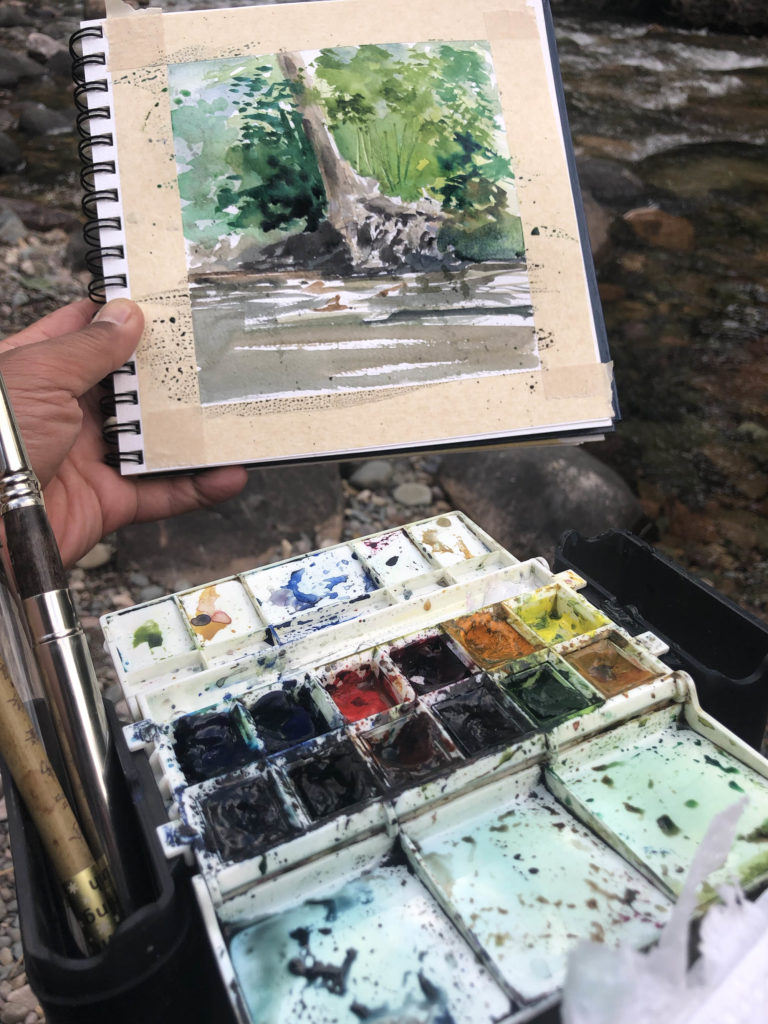
The Journeyman
You’re getting a little more serious and you’ve outgrown the student grade paints and want to take it to the next level. You know the colors you like. You want to use tube paints and customize your palette. This is where things get interesting. Once you go the empty palette route, the options widen. These are my recommendations.
Paint:
Daniel Smith Split Primary – artist grade, super pigmented, easy to re-wet, myriad of colors, made in Seattle.
Palette
Expeditionary Art Palettes – these are designed and curated by Maria in Portownsend, WA and what we used during the Swift Adventure Co. Trip with illustrator Chris McNally. Small. Lightweight. Expandable. And can be purchased pre-filled with Daniel Smith paints. Perfect for the urban sketcher that works on spot color, but can also be used strategically for more conventional watercolor wash techniques. You just have to be mindful of room and plan out your layers. Patreon members have a 15% off code for supporting the channel!
Portable Painter – popular with urban sketchers and also makes a great general watercolor palette, this is self-contained watercolor palette and water cup holder that is designed to rest on your knee! Probably my go to palette when on bike because of the integrated water cup. Downside is that it uses smaller than industry standard half pans and they don’t sell empty pans. Also, I wish both mixing panels had 3 large mixing areas.
Brush:
Da Vinci Caseno Quill in Size 2 and Size 4
Escoda Perla Travel Brush – size 12
Paper
Handbook 6×6 Watercolor Journal – Good balance between quality and price and comes in a variety of sizes to fit in your handlebar bag.
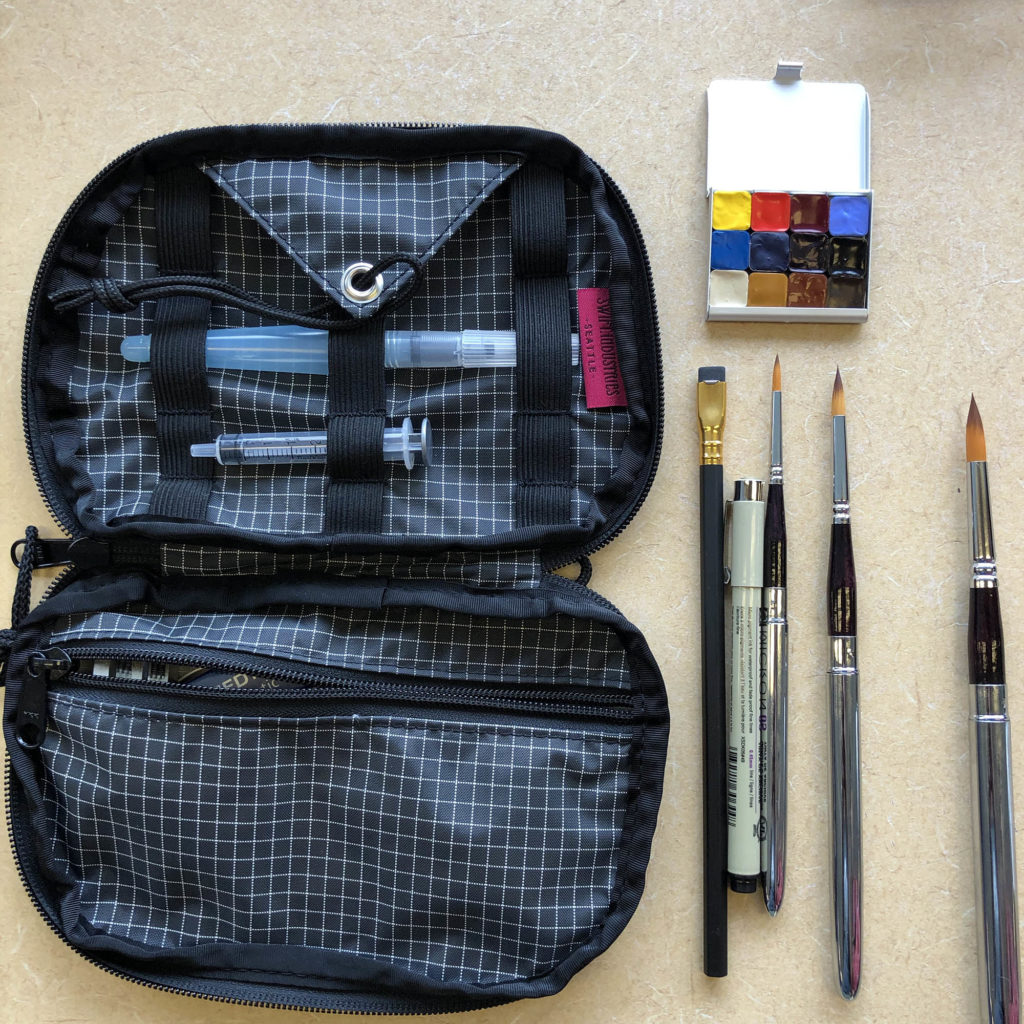
Pedaling Plein-air
You are all in and want the best of the best materials to capture your daily rides or your epic bike tour.
Paint: Daniel Smith Split Primary – why mess with perfection? 🙂
Palette:
Whiskey Painters Palette – strangely named, but these are great palettes. Heavy steel palettes with a white enamel coating that allows the paints to be mixed easier. What I love about these is the pans can be arranged to your hearts content with both half pans and full pans. They come in various sizes, the smaller Bijou or Flask (has an integrated water cup) version are great for travel. The full size palette offers 3 nice mixing wells but is definitely a little on the heavier side.
Holbein Steel Palette – these are getting harder to find and there are many aluminum knock-offs out on the market. If you can find a legit one, but it. They have a good enameled surface for easy mixing and the paint doesn’t bead on the surface. They have generous mixing areas and nice large wells that are easier to access with bigger brushes.
Paper:
Strathmore 500 Series Watercolor Journals and Pads – these journals are 100% cotton rag cold press paper that come in staple bound journals. They are about as a high quality as they get and allow for all the traditional watercolor techniques such as multiple washes, wet on wet and dry brush techniques. The texture makes it excellent for watercolor but will wear down pens like Microns a bit quicker because of their rough tooth.
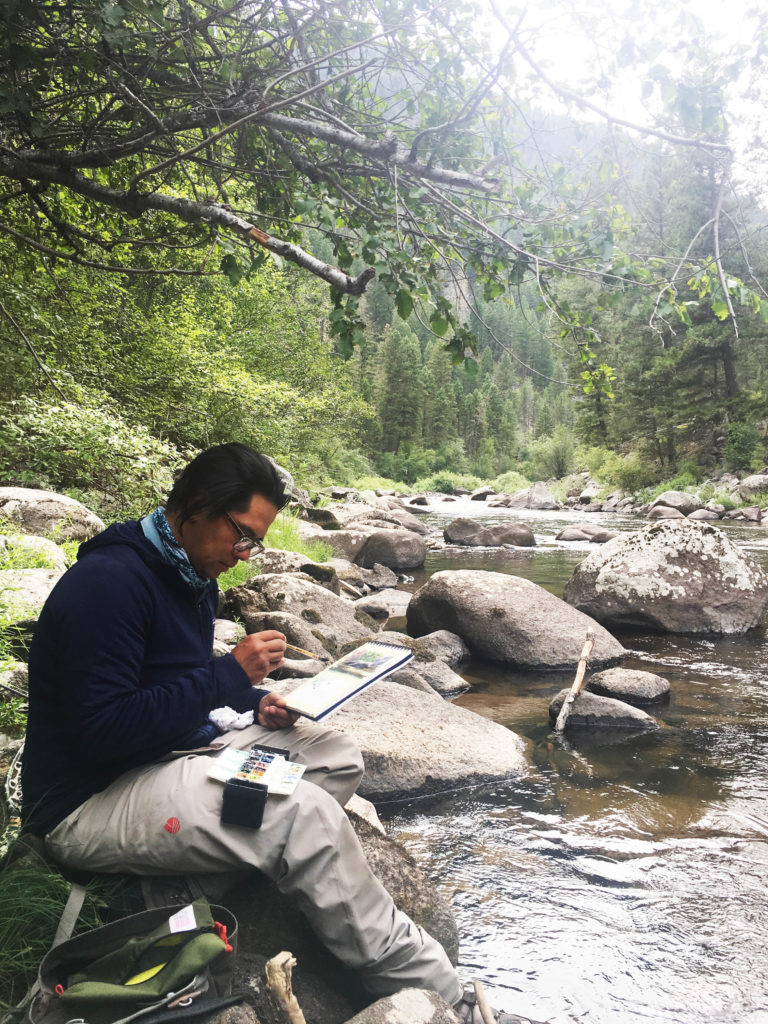
Miscellanea
With all these kits, you’ll need a good case to carry everything in. The Swift Industries Seeker bag makes a great soft case that has elastic webbing to secure brushes and pens, as well as a zippered compartment for palettes, extras and paper towels.
A portable camping chair is another nicety as well as a wide brim hat to keep the sun off your face when plein air painting.
With any of these kits you’ll be able to make great art and it really comes down to the tough part: practice, practice, practice. Don’t be discouraged in the beginning, watercolor has a mind of its own. I enjoy its sometimes unpredictability and how it requires you to work quickly. You can’t overwork watercolors or paint over things once you have it down, so it requires some planning and a lot of presence of mind, which is a nice change of pace from staring at a monitor all day.
Happy painting and pedaling!
Head over to our BigCartel Store to buy some of Russ’ watercolors and postcards!
Tags In
1 Comment
Leave a Reply
This site uses Akismet to reduce spam. Learn how your comment data is processed.
Subscribe
Patreon
Join Team Supple on Patreon
PayPal

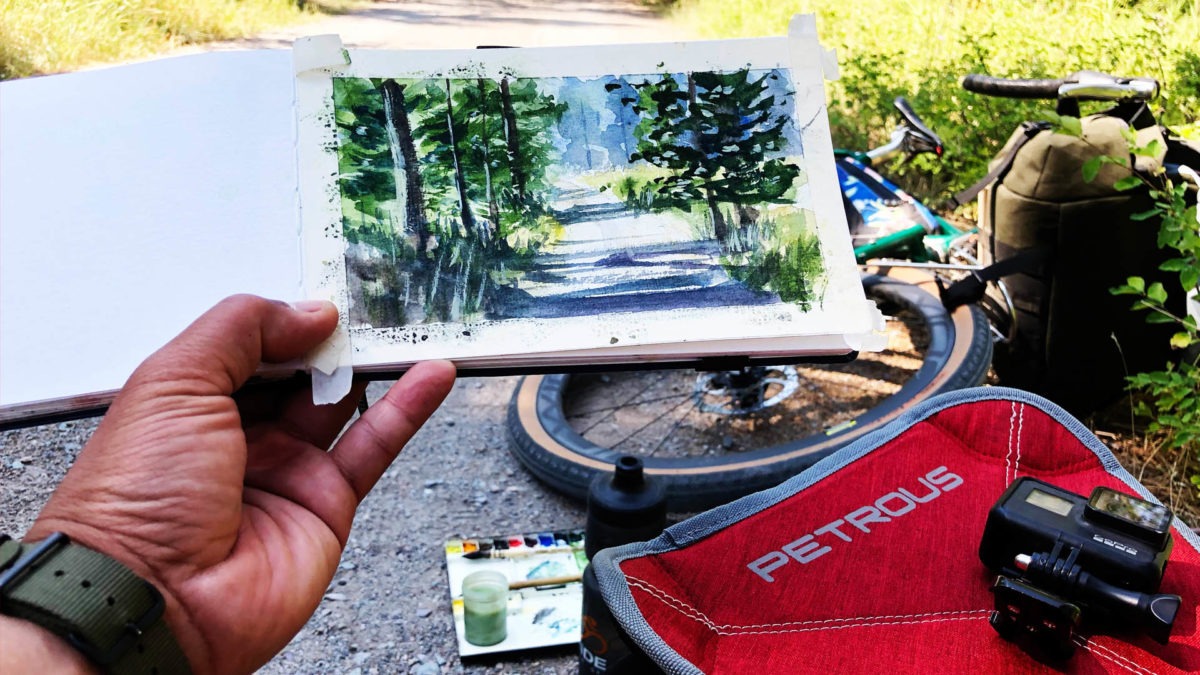
Heard you say self taught through YT. Did you subscribe to paint tutorials or free material, or both? Would you share valuable channel names? Thanks in advance.